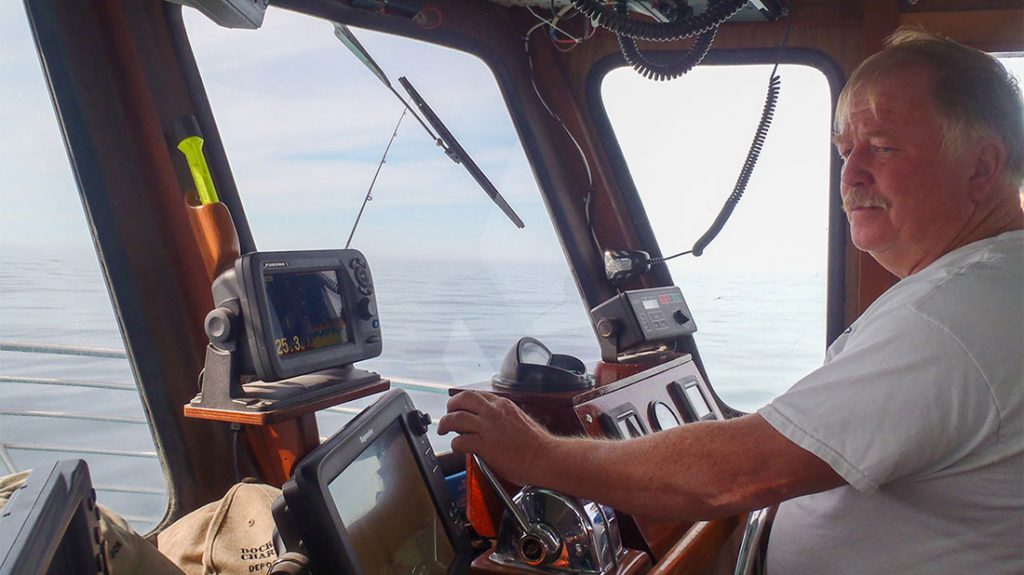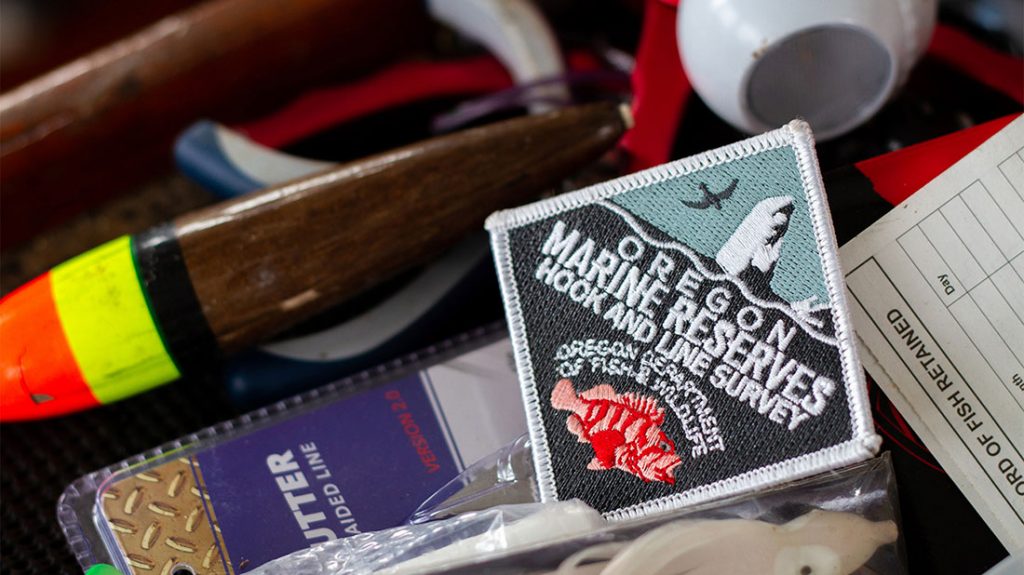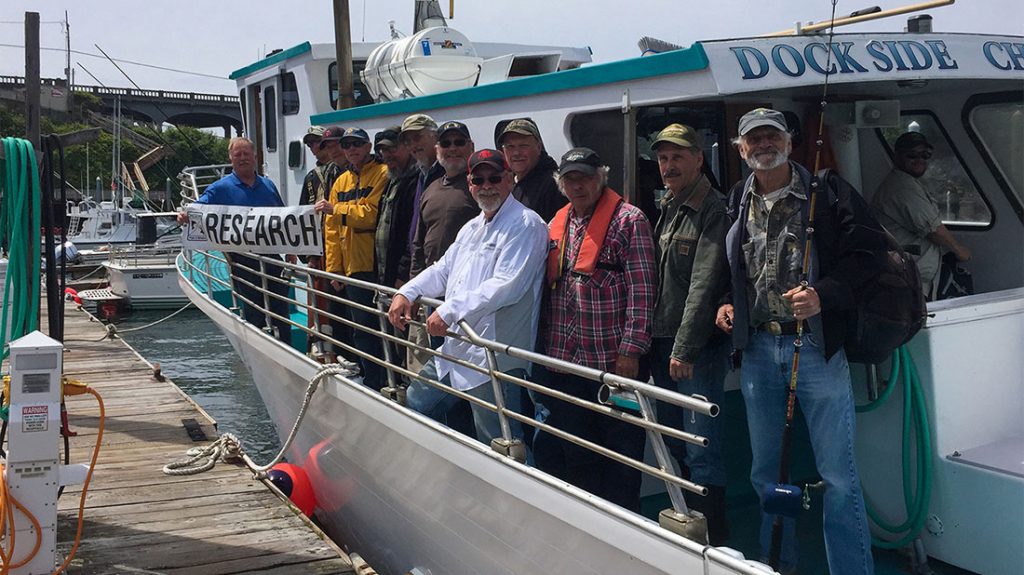Update Dec 2020
We lost our friend and long-time research collaborator, Lars Robison, in November of this year. Lars was a leader in his local community of Depoe Bay, a joy to work with in the field, and a gentle soul. Our hearts go out to his family and friends. We will miss him.
Lars Robison Checks In On His Backup Fishing Spot
With a profession spanning five decades off of a 15-mile stretch of coastline, this charter boat captain’s sense of place for the Cascade Head Marine Reserve area remains deep and unchanged. This is despite changes in management as well as his use and interactions with the area. Join us as we talk with Lars Robison and explore his knowledge of the reserve, how he came to know these waters, and his continued connections with this place.
By Guest Author: Vaughn Robison
Depoe Bay’s fishing fleet sits tied to the docks as Lars Robison makes himself comfortable in the captain’s chair of his 50-foot fishing vessel, the Samson. The captain is breaking from the boat’s routine off-season maintenance to discuss his connections and knowledge of the area now encompassed by the Cascade Head Marine Reserve. Despite his seat behind the wheel, Robison has no plans to throw his lines, cross the rough channel and head to sea on this blustery winter weekday.
The discussion that follows, however, takes an unplanned turn.
Photo: Robison references his mapping technologies while guiding a hook-and-line survey of Cascade Head Marine Reserve in 2016.
From his chair, Robison proceeds to explain the ways in which he knows the protected waters located 15 miles north of the harbor. He shares precise coordinates of the reserve’s boundaries and notes the businesses on the shoreline that line up with these boundary marks. He then pinpoints various types of underwater habitats and describes their shapes and structure. He tells of rock formations and their steep slopes, explaining the depth from the surface to the peak of their pinnacles and again to the bottom of the seafloor. Their measurements are told first in fathoms before he translates to feet. Weather conditions from each season are shared, as well as the corresponding direction and strength of the ocean’s current. He lists the variety of fish species, their seasonal availability and the history of their harvest before the reserve’s no-take fishing restrictions went into effect in 2014.
Robison’s rich description could feel like he is recounting a scene right before his eyes.
It’s a scene that, for many, would be incomplete without including the reserve’s namesake landmark. Robison, however, doesn’t mention the large coastal headland that protrudes into the reserve’s adjoining north marine protected area until he is asked about it.
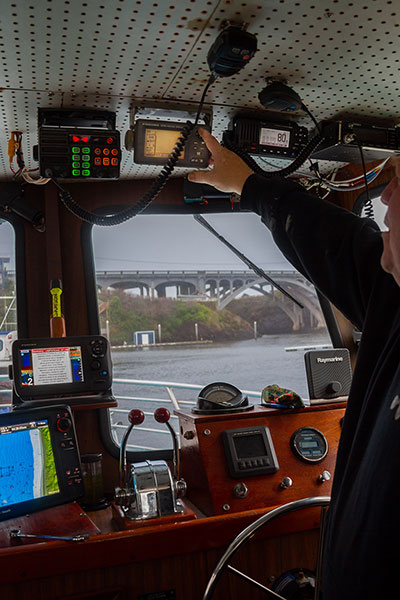
“The reserve is not off of Cascade Head,” he says protectively, “that’s just its name.”
Robison turns to one of four electronic mapping systems on his dashboard and moves the viewfinder to the reserve area to validate his statement. As he zooms in on the map, he recounts the confusion expressed by a group of sightseers that once chartered his boat to visit the area.
“I’ve taken people to go up and see Cascade Head Marine Reserve and they kind of get up there and say ok, ‘well this is nice, but where’s the reserve?’ ” Robison says, “Well the reserve is underwater. You can’t see it unless you have it all mapped out.”
It becomes increasingly clear that Robison has highly detailed maps of these waters not only in the dash of his boat, but also in his mind.
The captain uses these maps together as he serves as an ambassador to these places for guests aboard his boat. This role of chartering visitors to these waters is one that has played out in many acts all within the same setting. Apart from the occasional sightseeing excursion and a steady stream of whale-watching trips, Robison’s primary business is guiding sportfishing trips. It is a role that started in his preteens and led to a lifelong profession in which he has, with the exception of a few supplemental seasons in Hawaii and Alaska, worked exclusively out of Depoe Bay.
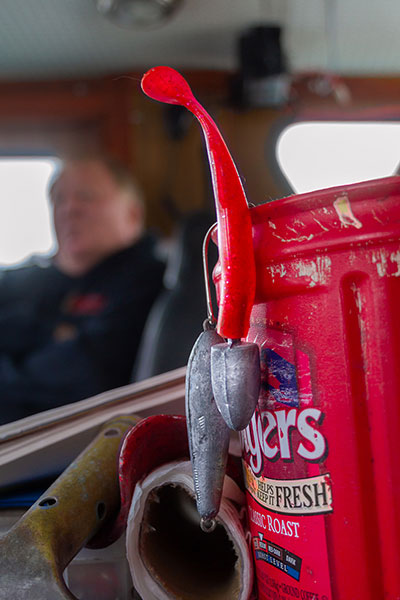
“I was a deckhand on my dad’s boat in 1968,” he says of his earliest encounters with the waters that would become Cascade Head Marine Reserve later in his lifetime. Robison’s early exposure to these waters paired with his continued interactions over the years helped shape and reinforce his personal identity. Social scientists call this process of understanding oneself directly in relation to a certain environment as “place identity.” For Robison, this identity is multi-generational.
“My dad was basically the only one bottom-fishing out of here [Depoe Bay] for quite a while,” he says of his father, a pioneer in the area’s charter fishing industry and to whom he credits both his initial connection to these waters and the foundation of his wealth of knowledge about them.
Robison’s father also started fishing the reserve area during childhood and drew upon his own father’s knowledge as he learned to access and navigate their waters from his childhood home on the Siletz Bay. Later in life, Robison’s father relocated from Taft to Depoe Bay and was instrumental in transitioning the harbor’s fishing activities from seasonal salmon, off-shore tuna and halibut fishing. Through experience and technological advancements that allowed a deeper understanding of the area, these fishing efforts came to include more reliable year-round opportunities by targeting species such as lingcod and rockfish that inhabit the area’s nearshore marine habitats.
“We didn’t keep black rockfish, just lingcod and yelloweye,” Robison mentions of his earliest fishing efforts in these waters.
With the exception of yelloweye rockfish, which is currently off limits to fishing, these species now account for the majority of the harbor’s fishing efforts. Robison is currently the only captain who caters exclusively to the demand of guests looking to fish these nearshore waters. While the rest of the fleet also guide an assortment of trips for guests looking to target off-shore species such as tuna and halibut, Robison’s expertise and connection to the place keeps him close to shore. He specializes in guiding guests who want to fish the same waters his family has been fishing for more than a century.
Photo: A commemorative patch given to the volunteer anglers who assisted in the 2017 marine reserve hook-and-line surveys lays alongside various fishing lures inside Robison’s wheelhouse.
Within his specialized history of fishing these nearshore waters, those of Cascade Head Marine Reserve always had an important meaning to Robison.
“It was a backup,” he says of the area that was farthest from the Depoe Bay fleet’s historic nearshore fishing range. “If you weren’t catching fish, you kept working your way up the coast to get them, and then come back down the line. It was usually really good at times because it didn’t get fished much.”
Social scientists often refer to this as “place dependence,” or an attachment to an area based on a very specific function that can’t be performed anywhere else. In addition there is “place meaning,” or a relationship to an area based on how a person thinks about the purpose and significance of a physical setting. Robison mentions that his meaning for this area wasn’t the same for other captains, a few of whom would use it as their first choice fishing grounds. To him, however, it was a reliable backup that was only tapped into when weather or fishing conditions warranted.
Having a dependable backup fishing spot and preserving the area’s fish populations has always been central to Robison’s identity as a charter boat captain. It is another attribute he credits to early experiences with his father. In a career that started before any fishing regulations existed on the size or total catch of these fish, father and son practiced informal ways to safeguard these fish populations.

“We put back all the big females, and of course we didn’t keep the small ones,” says Robison of the self-imposed management practice of releasing fish with large reproductive potential, “we just kept the medium-sized lingcod.”
“My dad went to the state and asked that there be a limit put on lingcod because he thought that would be the thing to do to, you know, to preserve it,” Robison recounts enthusiastically of his father’s petitioning for regulations in the 1960s. “The state wouldn’t do it. They said ‘There’s no problem with lingcod out there, and he said ‘How do you know? You have no research out there.’”
Fortunately, the state has long since formalized a catch limit on lingcod, and there’s a growing body of research on them and other fish that call these nearshore waters home. These days Robison plays a role in facilitating that research.
Robison has been chartered by ODFW over the years to guide the hook-and-line surveys conducted as part of the long-term monitoring of the Cascade Head Marine Reserve. These surveys occur every other year, sampling fish both inside and outside of the reserve, using catch-and-release fishing practices to track and understand changes in fish populations over time. For Robison, this is an opportunity to again serve as an ambassador to this place and share his knowledge with both the scientists and the volunteer anglers who assist with the ecological monitoring. Engaging in this process has also helped him gain further understanding of this place, by interacting with the scientists and the additional technologies they bring on board his boat.
Photo: Robison poses with volunteer anglers from the 2016 marine reserve hook-and-line survey while holding a banner hung aboard his boat during the trips to signal its research pursuits to potential observers.
“Some of the time in the marine reserve, as well as out here, we were dealing with oxygen depletion down on the bottom. We wouldn’t see fish, and we’d go up the line and still wouldn’t see them. So finally we put crab pots over the side up there with oxygen sensors in them and left them out there and pulled them up,” he says of learning about the impacts of hypoxia on nearshore environments that scientists at ODFW and Oregon State University are monitoring for, “and they sent those back to the lab and said ‘you’re not seeing fish on the bottom here because the oxygen level is low. They’re not there. There’s nothing wrong with your fishfinder.’”
The monitoring process is also an opportunity for him to check in on his old backup fishing spot.
“It felt really good,” he says while turning back to his screen and dialing the map to individual areas of the reserve, demarcated as containing rocky habitat, where hook-and-line sampling occurs. “I wanted …” he says before correcting himself, “everyone wanted to see how it was going because we gave up a lot.”
His statement stands in stark contrast to the feelings he has for the process of losing fishing access to this area in the first place.
“It didn’t feel very good, because in the meetings we thought we were going to lose a lot more than that,” Robison says of the process for determining the marine reserve locations that was assisted by local communities, “we knew we were going to lose something and that we had to put something in out there.”
For Robison, the process of sacrificing access to these waters as a charter fisherman was not easy, but he doesn’t believe it has changed his sense of connection or concerns for the place. And despite his excitement for returning to the reserve, to help facilitate research for which he has long advocated, this didn’t change his connection to the area either.
“It didn’t make me care any more or less about the place,” he says of revisiting his backup fishing spot and learning more about the ways in which it functions, “I’ve always cared about the place.”

The reserve’s conservation goals for the area could be considered similar to Robison’s place dependence for the area as a backup. Goals of the reserve include conserving marine habitats and biodiversity. The size, habitats, and previous fishing pressure of the Cascade Head Marine Reserve make this site a good candidate for potentially seeing greater average sizes of fish and higher densities of fish in the reserve in the future. However, scientists project a minimum of 10-15 years and for some species as long as 40 years after protections have been in place before these types of changes may be detectable. Lesser known is whether fish from this reserve might eventually move to other areas of the ocean through a process known as “spillover,” wherein a protected area reaches its carrying capacity causing some adult fish to relocate to surrounding waters where fishing is allowed.
But the Cascade Head Marine Reserve also raises concerns for Robison, as he mentions his current worry for other areas of the ocean.
“[The reserve] cut down the catch a lot, because it was so good up there,” he says,” and it’s forced us to put more fishing pressure on other areas.”
“As far as this great spillover,” Robison says, “I just don’t think we’ve seen that.”
Robison could very well be the first to see some of the changes in the fish population, whether with a boat full of researchers or a boat full of sportfishers. It is something he hopes to see either way sooner than later. For now, though, he has to get back to work fixing his boat and flips off the screens to his monitors. That is one thing about the place he can’t see while still tied to the dock.

